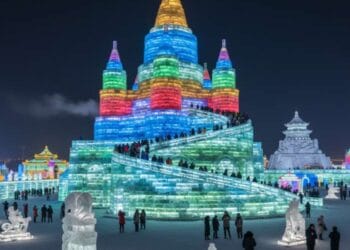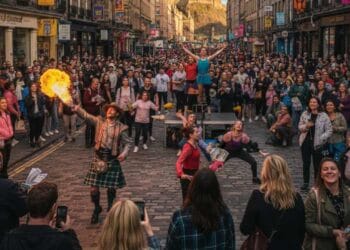The history of Vrindavan is deeply rooted in Hindu mythology and religious beliefs. According to legends, Vrindavan is associated with Lord Krishna, one of the most revered and beloved deities in Hinduism. The city’s origin is intricately linked to Lord Krishna’s divine pastimes and childhood exploits.
According to ancient texts like the Bhagavata Purana and Vishnu Purana, Vrindavan is believed to be the place where Lord Krishna spent his early years as a cowherd. It is said that Krishna and his elder brother Balarama were brought to Vrindavan by their parents, Vasudeva and Devaki, to protect them from the evil King Kansa, who wanted to kill them.
The sacred forests, meadows, and the Yamuna River of Vrindavan are believed to have witnessed Lord Krishna’s enchanting pastimes (leelas) with his divine consort Radha and his cowherd friends (gopis). These divine tales of love and devotion form the basis of many Hindu scriptures, poetry, and folklore, making Vrindavan an important pilgrimage site for Krishna devotees.
Over the centuries, numerous temples have been built in Vrindavan to celebrate and honor the presence and divine acts of Lord Krishna. Some of the most famous temples in Vrindavan include the Banke Bihari Temple, ISKCON Temple, and Prem Mandir.
With time, Vrindavan became a major center of Vaishnavism, a branch of Hinduism that worships Lord Vishnu and his avatars, especially Lord Krishna. Today, the city attracts devotees, scholars, and tourists from around the world who seek spiritual peace and wish to experience the divine atmosphere of this sacred place.

How to Travel from Delhi to Vrindavan (Uttar Pradesh)?
To travel from Delhi to Vrindavan, Uttar Pradesh, you have several transportation options:
- By Road:
- The most common route from Delhi to Vrindavan is by road. You can hire a taxi or drive your own vehicle. Depending on traffic and the route taken, the journey usually takes about 3–4 hours.
- By Train:
- Another convenient option is to take a train from Delhi to Mathura, which is the nearest major railway station to Vrindavan. Multiple trains run regularly between Delhi and Mathura. Once in Mathura, you can take a taxi, auto-rickshaw, or local bus to Vrindavan, which is around 10–15 minutes away.
- By Bus:
- Direct buses are also available from Delhi to Vrindavan. Both government and private operators serve this route. Depending on traffic and the type of bus, the journey can take about 4–5 hours.
- By Air:
- Though Vrindavan does not have its own airport, you can fly to the nearest airport, which is the Indira Gandhi International Airport in Delhi. From there, you can hire a cab or taxi to Vrindavan, which is about 150 kilometers away.
Before traveling, it’s advisable to check the latest travel options and schedules for effective planning. Also, consider the current weather and travel time for a comfortable journey.
Fame of Vrindavan (Uttar Pradesh)
Vrindavan is highly famous and significant for several reasons:
- Religious Importance: Due to its association with Lord Krishna, Vrindavan is considered one of the holiest places for Hindus. It is believed to be the site where Lord Krishna spent his childhood and performed divine pastimes with his beloved Radha and the gopis.
- Krishna Pilgrimage: As a result of its connection to Lord Krishna, Vrindavan has become a major pilgrimage center for millions of Krishna devotees from India and across the world. Pilgrims visit the city seeking spiritual blessings and to immerse themselves in devotion and traditions associated with Krishna.
- Temples and Ashrams: Vrindavan is home to numerous temples and ashrams dedicated to Lord Krishna and Radha. These temples, such as the Banke Bihari Temple, ISKCON Temple, and Prem Mandir, are not only sites of worship but also architectural marvels that showcase rich cultural heritage.
- Festivals and Celebrations: During various Hindu festivals—especially Janmashtami (Krishna’s birthday)—Vrindavan comes alive with grand processions, music, dance, and colorful celebrations that attract both devotees and tourists alike.
- Cultural Significance: Vrindavan is a hub of traditional art forms, music, dance, and religious discourses. It has inspired countless poets, musicians, and artists who express their devotion through various forms of art.
- Spiritual Retreat: Vrindavan offers a serene atmosphere, making it an ideal destination for spiritual retreat and self-reflection. Many yoga and meditation practitioners visit Vrindavan to seek inner peace and wisdom.
- Tourism: Beyond its religious appeal, Vrindavan also attracts tourists interested in exploring its rich cultural heritage and vibrant spiritual environment.
Overall, Vrindavan’s fame as a place of divine love, devotion, and spiritual essence transcends borders, making it a favored destination for those seeking a deep connection with divinity and Indian cultural traditions.
Food Options in Vrindavan (Uttar Pradesh)
Vrindavan offers a wide variety of food options catering to both locals and tourists. The city’s culinary scene reflects its rich cultural heritage and religious significance. Here are some popular food choices you can find in Vrindavan:
- Vegetarian Food: Due to its religious nature, Vrindavan is predominantly vegetarian. You’ll find a variety of vegetarian dishes influenced by traditional Indian cuisine.
- Prasadam: Many temples in Vrindavan offer prasadam—holy food that is blessed and distributed to devotees. These are considered highly auspicious and often include sweets and cooked meals.
- Chappan Bhog: This is a special offering consisting of 56 different food items presented to deities in certain temples. Some eateries also serve a version of Chappan Bhog for devotees and visitors.
- Peda and Other Sweets: Vrindavan is famous for its peda, a milk-based sweet. Local sweet shops also offer a wide range of traditional Indian sweets.
- North Indian Cuisine: A variety of North Indian dishes such as dal makhani, paneer dishes, aloo paratha, and various types of bread (rotis) are widely available in Vrindavan.
- Street Food: Vrindavan’s streets are lined with vendors selling snacks like samosas, kachoris, pakoras, and chaat, which are popular among tourists.
- South Indian Cuisine: Some restaurants also serve South Indian dishes like dosa, idli, and vada to cater to a wider range of visitors.
- International Cuisine: In recent years, with the influx of international tourists, some restaurants in Vrindavan have started offering global dishes as well.
- Ayurvedic and Sattvic Food: Some restaurants and ashrams in Vrindavan serve Ayurvedic and sattvic meals, which are simple, pure, and believed to be beneficial for the mind and body.
When in Vrindavan, you’ll find plenty of options to satisfy your taste buds, and exploring the local food culture is an integral part of the overall experience. Make sure to try different eateries and sample various dishes to get the most out of your culinary journey in this spiritual city.
Accommodation Options for Travelers in Vrindavan (Uttar Pradesh)
Vrindavan offers a wide range of accommodation options to cater to the needs of pilgrims, tourists, and travelers. These options range from budget-friendly lodges to mid-range hotels and more luxurious resorts. Here are some types of accommodations you can find in Vrindavan:
- Ashrams: Many ashrams in Vrindavan provide simple and affordable accommodation for spiritual seekers and pilgrims. Staying at an ashram can offer a more immersive experience of the city’s spiritual environment.
- Guesthouses and Dharamshalas: There are many guesthouses and dharamshalas (charitable lodgings) that provide basic amenities at reasonable rates. These are often run by religious organizations or trusts.
- Budget Hotels: Vrindavan has several budget hotels and lodges offering comfortable and affordable stays. These provide essential amenities and are ideal for budget-conscious visitors.
- Mid-range Hotels: These offer better amenities and more comfort at reasonable prices. Many travelers opt for these for a more pleasant experience.
- Resorts: For those seeking a more luxurious stay, Vrindavan also has some resorts that offer premium services, scenic surroundings, and a peaceful atmosphere.
- Temple-affiliated Guesthouses: Some temples in Vrindavan have their own guesthouses where devotees and travelers can stay at nominal charges.
- Online Booking Platforms: Travelers can also use online booking platforms to find various accommodation options in Vrindavan, often including guest reviews and ratings.
During peak pilgrimage seasons and major festivals, it is advisable to book your stay in advance as Vrindavan draws large crowds. Whether you prefer a simple spiritual retreat or a more comfortable stay, Vrindavan has accommodations suited to various preferences and budgets.










